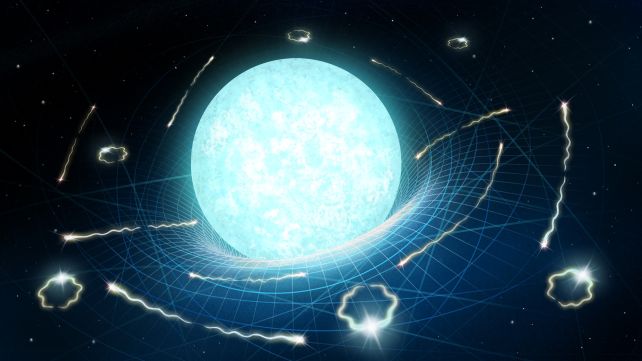A new calculation of the end of the Universe suggests that the end of all things will come a lot sooner than our previous calculations indicated.
Once the Hawking-like radiation emitted by everything in the Universe is taken into account, the functional end of the Universe is a mere 1078 years hence. Okay, so humanity will well and truly be dead by then, sure – but it's a lot less than the 101,100 years we thought the Universe had.
"So the ultimate end of the Universe comes much sooner than expected," says astrophysicist Heino Falcke of Radboud University in the Netherlands, "but fortunately it still takes a very long time."
The work is a direct follow-up on a 2023 paper, in which Falcke and his colleagues, Michael Wondrak and Walter van Suijlekom, found that black holes are not the only things in the Universe that emit Hawking radiation. Rather, less dense objects could also undergo a gradual evaporation in the form of Hawking radiation, or something like it.

It's a little complicated, and we go into it in more detail here if you need a refresher, but the basic gist is that Hawking-like radiation – the spontaneous production of particles that fly off, carrying some of the black hole's energy with them – can happen at less extreme space-time curvatures.
Traditionally it was thought to require an event horizon – the point at which the gravitational pull of a black hole is so strong that even light speed is no longer sufficient to attain escape velocity.
However, the team found in the 2023 study that it could also occur around other ultradense or very massive objects. This means that the space warping around neutron stars and white dwarfs, as well as massive galaxy clusters, should also be facilitating evaporation, according to the team's model.
"After a very long period, that would lead to everything in the Universe eventually evaporating, just like black holes," Falcke explained in 2023. "This changes not only our understanding of Hawking radiation but also our view of the Universe and its future."
Well, the obvious next question is: how long is that going to take? So, the team knuckled down and crunched the numbers.
White dwarfs, neutron stars, and black holes all belong to the same family of objects. They're what's left of a star after it dies; the outer material is ejected, and the core collapses into an ultradense object.
A star up to around 8 times the mass of the Sun turns into a white dwarf, which has an upper mass limit of 1.4 Suns. Massive stars between 8 and 30 solar masses produce neutron stars with an upper mass limit of around 2.3 solar masses. Stars more massive than 30 solar masses become black holes. There are limits there, too; they're not relevant right now, but you can read a little about it here if you like.
The denser an object is, the more extreme its gravitational field. Of the three objects, black holes are the most dense, and white dwarfs the least. This means that white dwarfs would take the longest time to evaporate; the time it takes for a white dwarf to die is the yardstick by which the team measured the remaining lifespan of the Universe.
Because black holes have the highest density and therefore the strongest gravitational fields, the team expected that they would take the shortest time to evaporate. Well, they were sort of right. It takes 1067 to 1068 years for a stellar mass black hole to whistle away to nothing – but, surprisingly, it takes neutron stars about the same amount of time.

There's a pretty interesting reason for this. "Black holes have no surface," Wondrak says. "They reabsorb some of their own radiation, which inhibits the process."
For an average white dwarf, the team calculated a lifespan of 1078 years, putting a rough upper limit on the lifespan of regular matter in the Universe.
There are, however, things in the Universe that would take longer than a white dwarf – assuming, of course, that no other fate befell them in the meantime. It would take the Moon 1089 years to evaporate. A human body would take 1090 years… so, even if we wanted to live forever, we might eventually run into an obstacle there.
A supermassive black hole would take 1096 years, while the giant halo of dark matter that engulfs a galactic supercluster would take 10135 years. Even that is far shorter than the 101,100-year lifespan based on the previous estimated lifespan of a white dwarf remnant.
Obviously none of this is really going to cause us any problems. Even if humanity does somehow become interstellar before the death of the Sun in 5 billion years, we'd have to then somehow continue existing for many times the current lifespan of the Universe.
What the team hopes is that their results will help us understand the Universe a little better before we go. And that, at least, we may still have time for.
"By asking these kinds of questions and looking at extreme cases," van Suijlekom says, "we want to better understand the theory, and perhaps one day, we unravel the mystery of Hawking radiation."
The research has been published in the Journal of Cosmology and Astroparticle Physics.
